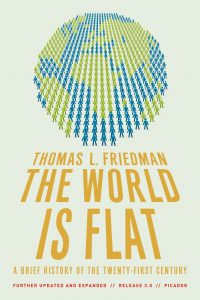The World is Flat – Thomas Friedman

Friedman argues that several flatteners including ubiquitous broad band, increased specialization accessible from anywhere on the globe, and an influx of talented and ambitious workers from around the world have converged to disrupt a world many had taken for granted. Namely, American supremacy in industry and innovation.
The text provides context for China’s controversial Made in China 2025 plan and the current trade disputes roiling markets around the globe. A flatter world is one characterized by shifting power dynamics and fluidity of capital. Supply chains and operations are global and a country’s ability to cultivate and harvest their human talent is their most powerful predictor of success.
It is also a world with marked inequality where those with technical skills and capital are enjoying a larger share of the pie, while the rest are competing for decreasing opportunities.
Written before the advent of big data and wide scale AI deployments, the challenges and opportunities outlined in the book are more relevant today than when it was published. If global connectivity, more sophisticated workflows and collaborations have flattened the world, what are the implications when they are combined with cloud computing, artificial intelligence, and the IoT (internet of things)? Unfortunately I don’t have a compelling answer to that question, however an anecdote from the book encapsulates my sense of the world and what’s next:
Every morning in Africa, a gazette wakes up and knows it must outrun the fastest lion or it will be killed. Every morning a lion wakes up and knows it must outrun the slowest gazelle or it will starve. It doesn’t matter if you are a lion or gazelle, when the sun comes up, you better start running.